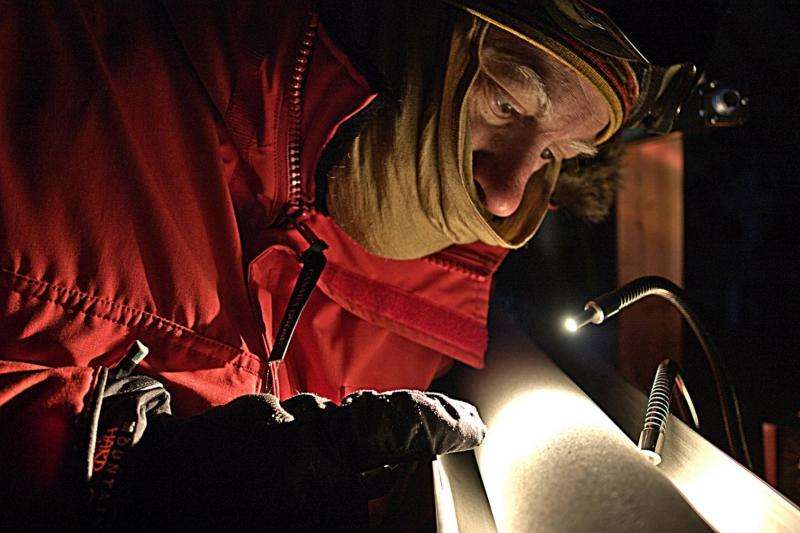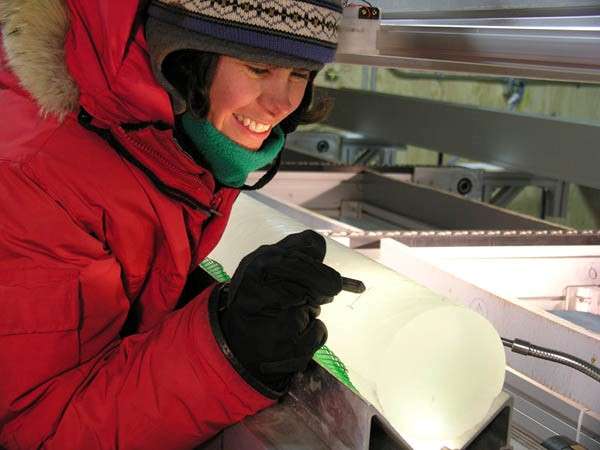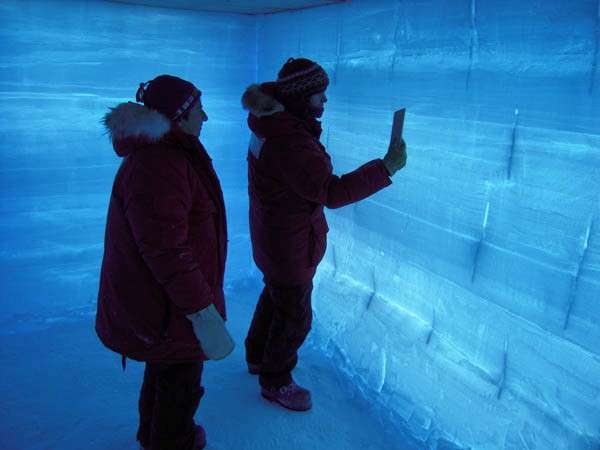North–south climate divide: Researchers find 200-year lag between climate events in Greenland, Antarctica

A new study using evidence from a highly detailed ice core from West Antarctica shows a consistent link between abrupt temperature changes on Greenland and Antarctica during the last ice age, giving scientists a clearer picture of the link between climate in the northern and southern hemispheres.
Greenland climate during the last ice age was very unstable, the researchers say, characterized by a number of large, abrupt changes in mean annual temperature that each occurred within several decades. These so-called "Dansgaard-Oeschger events" took place every few thousand years during the last ice age. Temperature changes in Antarctica showed an opposite pattern, with Antarctica cooling when Greenland was warm, and vice versa.
In this study funded by the National Science Foundation and published this week in the journal Nature, the researchers discovered that the abrupt climates changes show up first in Greenland, with the response to the Antarctic climate delayed by about 200 years. The researchers documented 18 abrupt climate events during the past 68,000 years.
"The fact that temperature changes are opposite at the two poles suggests that there is a redistribution of heat going on between the hemispheres," said Christo Buizert, a post-doctoral research at Oregon State University and lead author on the study. "We still don't know what caused these past shifts, but understanding their timing gives us important clues about the underlying mechanisms.
"The 200-year lag that we observe certainly hints at an oceanic mechanism," Buizert added. "If the climatic changes were propagated by the atmosphere, the Antarctic response would have occurred in a matter of years or decades, not two centuries. The ocean is large and sluggish, thus the 200-year time lag is a pretty clear fingerprint of the ocean's involvement."
These past episodes of climate change differ in a major way from what is happening today, the researchers note. The abrupt events of the ice age were regional in scope - and likely tied to large-scale changes in ocean circulation. Warming today is global and primarily from human carbon dioxide emissions in the Earth's atmosphere.
The key to the discovery was the analysis of a new ice core from West Antarctica, drilled to a depth of 3,405 meters in 2011 and spanning the last 68,000 years, according to Oregon State paleoclimatologist Edward Brook, a co-author on the Nature study and an internationally recognized ice core expert.
Because the area where the ice core was drilled gets high annual snowfall, Brook said, the new ice core provides one of the most detailed records of Antarctic temperatures at a very high resolution. Greenland temperatures were already well-established, the researchers say, because of high annual snowfall and more available ice core data.

"Past ice core studies did not reveal the temperature changes as clearly as this remarkable core," said Eric Steig, a professor in the Department of Earth and Space Sciences at the University of Washington, who co-wrote the paper. Steig's laboratory made one of the key measurements that provides past Antarctic temperatures.
"Previous work was not precise enough to determine the relative timing of abrupt climate change in Antarctica and Greenland, and so it was unclear which happened first," Steig noted. "Our new results show unambiguously that the Antarctic changes happen after the rapid temperature changes in Greenland. It is a major advance to know that the Earth behaves in this particular way."
Kendrick Taylor, chief scientist on the project, said the core enabled the research team to get the relative timing of Greenland and Antarctic temperatures down to several decades.

"We needed a climate record from the Southern Hemisphere that extended at least 60,000 years into the past and was able to resolve fast changes in climate," said Taylor, from the Desert Research Institute in Nevada. "We considered sites all over Antarctica before selecting the site with the best combination of thick ice, simple ice flow and the right amount of annual snowfall."
Taylor and colleagues formed a science and engineering team consisting of 28 laboratories from around the United States. "The resulting information provides unprecedented detail about many aspects of the Earth's past climate," Taylor said. "This will provide a generation of climate researchers a way to test and improve our understanding of how and why global climate changes."
OSU's Buizert said it is "very likely" that the Atlantic Meridional Overturning Circulation, or AMOC, is involved in these abrupt climate reversals.

"This ocean circulation brings warm surface waters from the tropics to the North Atlantic," said Buizert, who is in OSU's College of Earth, Ocean, and Atmospheric Sciences. "As these water masses cool, they sink to the bottom off the ocean. This happens right off the coast of Greenland, and therefore Greenland is located in a sweet spot where the climate is very sensitive to changes in the AMOC."
Brook said the AMOC seems to be critical, but was probably part of a combination of factors that ultimately controlled these past abrupt changes.
"Although ocean circulation may be the key, there are probably other feedbacks involved, such as the rise and fall of sea ice and changes in ice and snow cover on land," Brook said. "There is probably some kind of threshold in the system - say, in the salinity of the surface ocean - that triggers temperature reversals.
"It's not a problem to find potential mechanisms; it's just a question of figuring out which one is right. And the precise timing of these events, like we describe in this study, is an important part of the puzzle."
More information: Nature, DOI: 10.1038/nature14401
Journal information: Nature
Provided by Oregon State University




















